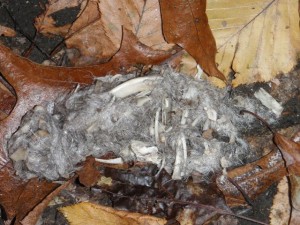Mariton: Scatology
by Tim Burris, Preserve Manager

While it may not be breakfast conversation, checking animal scat is interesting. It can tell us about the animals using our preserves. It also tells us what they are eating, what fruits are ripe and what insects are abundant.
This Coyote scat that I found in the Main Trail, tells me volumes. For instance, I only find coyote scat about once every few months. I don’t believe coyotes live at Mariton, but I do believe they visit occasionally as part of a large loop of hunting territory. This was fairly fresh, less than a week old. So, I know coyotes are moving (or have already passed) through. If I find more in other locations at Mariton, I might think they spent a couple days here.
Without too much prying with a stick I found a jaw bone and other large bones of a meal. The jaw bone wasn’t intact, but I thought it looked like a raccoon jaw.
Disclaimer: Poking at scat isn’t so bad. Just remember to wash your hands with soap and water. And Don’t, DON’T, DON’T play with raccoon scat. Raccoon feces can contain thousands of microscpic eggs from a roundworm (Baylisascaris prosyonis) that can be really dangerous if inhaled or entering a cut. Raccoons can have some other nasty parasites. What are the chances? I don’t know, however, I don’t poke raccoon scat anymore.
